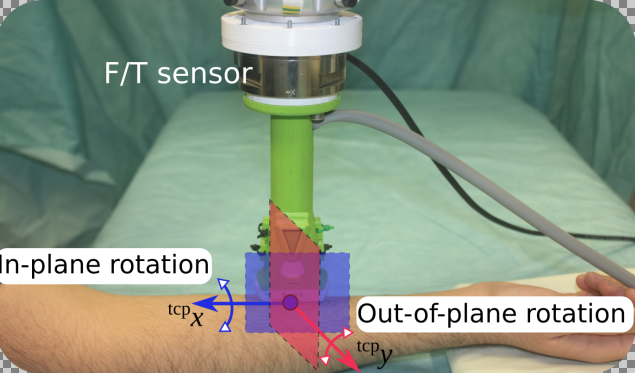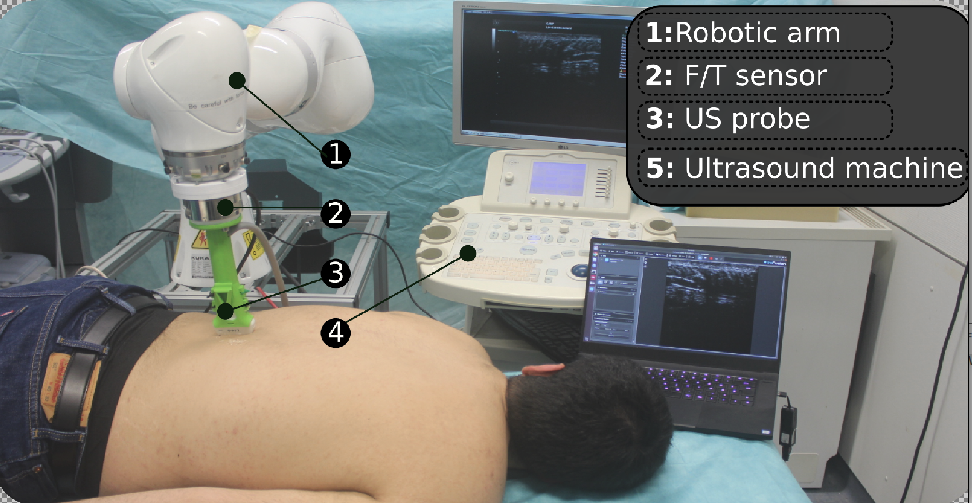Automatic Robotic Ultrasound Scan
We are looking for motivated students to work on a research topic in the field of medical robotics and human-robot interaction. In this project, we aim to develop a robotic ultrasound system to automatically complete the ultrasound scan task and even give basic diagnosis results. Some sub-projects listed as follows:
1) Fuzzy Force Control in Robotic Ultrasound;
2) Vision-Based Automatic Scan for 3D Ultrasound Imaging;
3) repeatedly and accurately place the US probe in the same relative orientation of tested tissue based on the US imaging (e.g. orthogonal direction of the vessel);
4) sonographer-robot shared control for better scanning: the human can adjust the robot’s position and applied force between the probe and tested tissue during the scanning [4].
 |
 |
1) Fuzzy Force Control in Robotic Ultrasound
Ultrasound (US) imaging is widely used for real-time diagnosis of internal tissue and organs. The contact force between the US probe and tested tissue is crucial for achieving high-quality US imaging. However, it is not possible to apply a constant force for a free-hand US scan, even for experienced US operators.
Thus, the robot is employed to facilitate obtaining accurate and repeatable US scans [1]. Some robotic systems are proposed to reduce image variations by providing a known contact force [2]. Instead of designing a specified mechanism, we are going to develop a fuzzy controller to maintain the given force by tuning the robotic motion parameters. A fuzzy force control was designed specifically for vertebral lamina milling in [3].
The goal of the thesis is to accurately maintain a given contact force via a fuzzy control strategy for the US scan on a non-planar surface or even non-stationary ones.
2) Vision-Based Automatic Scan for 3D Ultrasound Imaging
Ultrasound (US) imaging is widely used for real-time diagnosis of internal tissue and organs. It provides the B-scan with low cost and no radiation in real-time. Traditional 2D US scan dynamically displays 2D images of the region of interest. However, the lack of 3D anatomy information makes the diagnosis results heavily depend on the doctors’ experience and very hard to repeatedly place the probe in the same position, even for experienced operators.
Thus, the robot is employed to facilitate obtaining accurate and repeatable US scans [1]. Benefited from the compliant controller, the contact force between the probe and scanned tissue can be accurately maintained during the scan. To leverage the knowledge of stenographers, the scanned path is manually drawn on the surface of tested tissues via a marker pen. Then the orientation can be adjusted to be perpendicular to the scanned tissue in real-time based on the detected manually line. Thus, the US acquisition (force, orientation and contact point) [2] have been accurately represented.
The goal of the thesis is to realize accurately robotic-assisted 3D US imaging for large scale scans (e.g. whole leg or arm) based on the computer vision.
Skills and Qualifications: The candidate should have a good motivation to work on challenging and new ideas. Knowledge in robotic control is a plus.
Preferably master thesis. Also possible as guided research.
REFERENCE
- [1] Jiang et al. Automatic Normal Positioning of Robotic Ultrasound Probe based only on Confidence Map Optimization and Force Measurement. RAL (presented in ICRA2020)
- [2] Gilbertson et al. "Force and position control system for freehand ultrasound." IEEE Transactions on Robotics 31.4 (2015): 835-849.
- [3] Deng et al. "Fuzzy force control and state detection in vertebral lamina milling." Mechatronics 35 (2016): 1-10.
- [4] Lauretti et al. A Surgeon-Robot Shared Control for Ergonomic Pedicle Screw Fixation. RAL (presented in ICRA2020)
Advisor: Prof. Nassir Navab
Supervision: Zhongliang Jiang,
Dr. Mingchuan Zhou
Please drop an email to
Zhongliang Jiang if you want to find out more.

